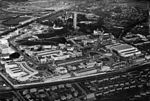Bellahouston Park Halt railway station
1938 establishments in Scotland1939 disestablishments in ScotlandDisused railway stations in GlasgowFormer London, Midland and Scottish Railway stationsGlasgow railway station stubs ... and 4 more
Pages with no open date in Infobox stationRailway stations in Great Britain closed in 1939Railway stations in Great Britain opened in 1938Use British English from February 2021
Bellahouston Park Halt railway station served the district of Bellahouston, Glasgow, Scotland, from 1938 to 1939 on the Paisley Canal line.
Excerpt from the Wikipedia article Bellahouston Park Halt railway station (License: CC BY-SA 3.0, Authors).Bellahouston Park Halt railway station
Paisley Road West, Glasgow Bellahouston
Geographical coordinates (GPS) Address Nearby Places Show on map
Geographical coordinates (GPS)
| Latitude | Longitude |
|---|---|
| N 55.8455 ° | E -4.3183 ° |
Address
Sunken Garden
Paisley Road West
G52 1EQ Glasgow, Bellahouston
Scotland, United Kingdom
Open on Google Maps




